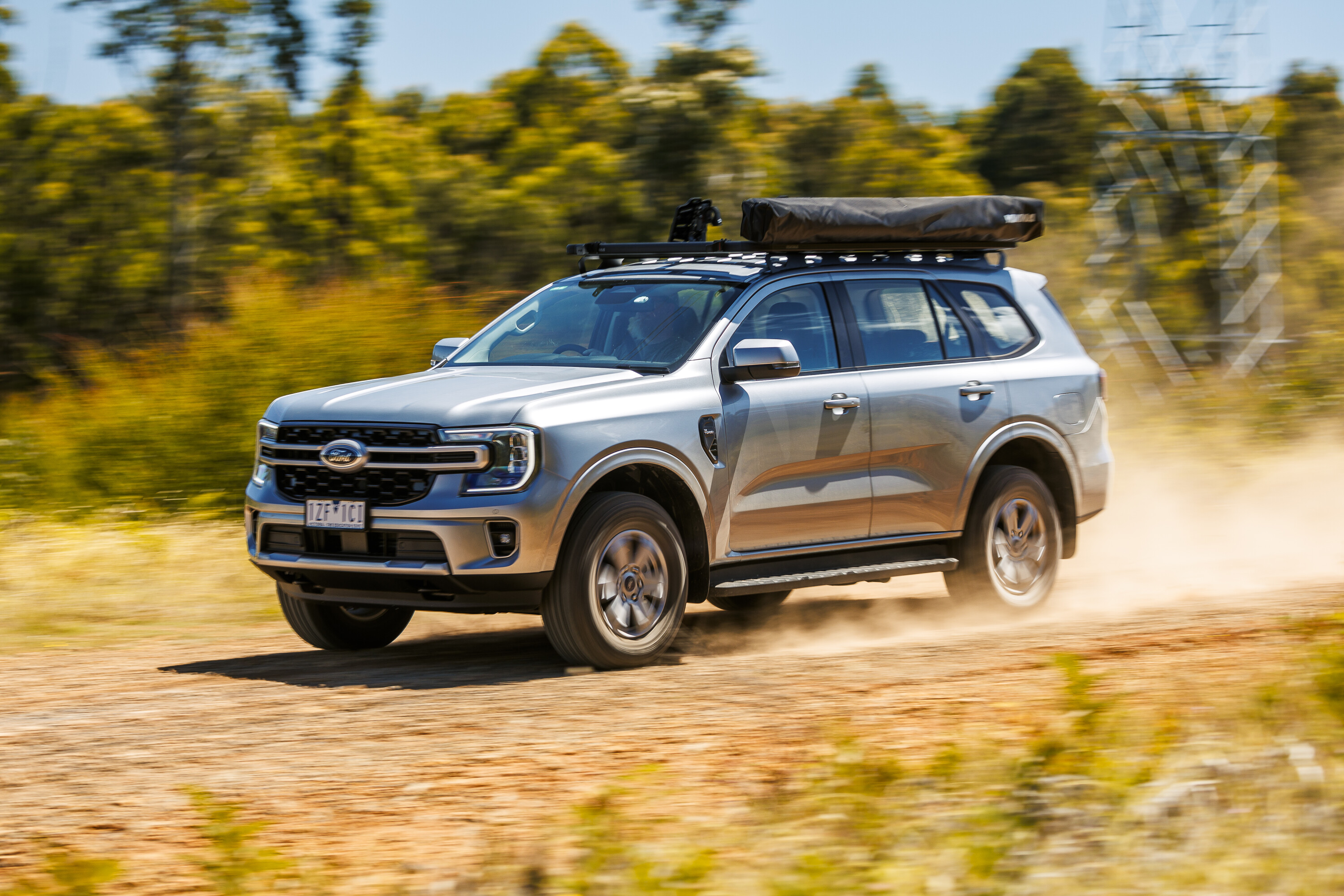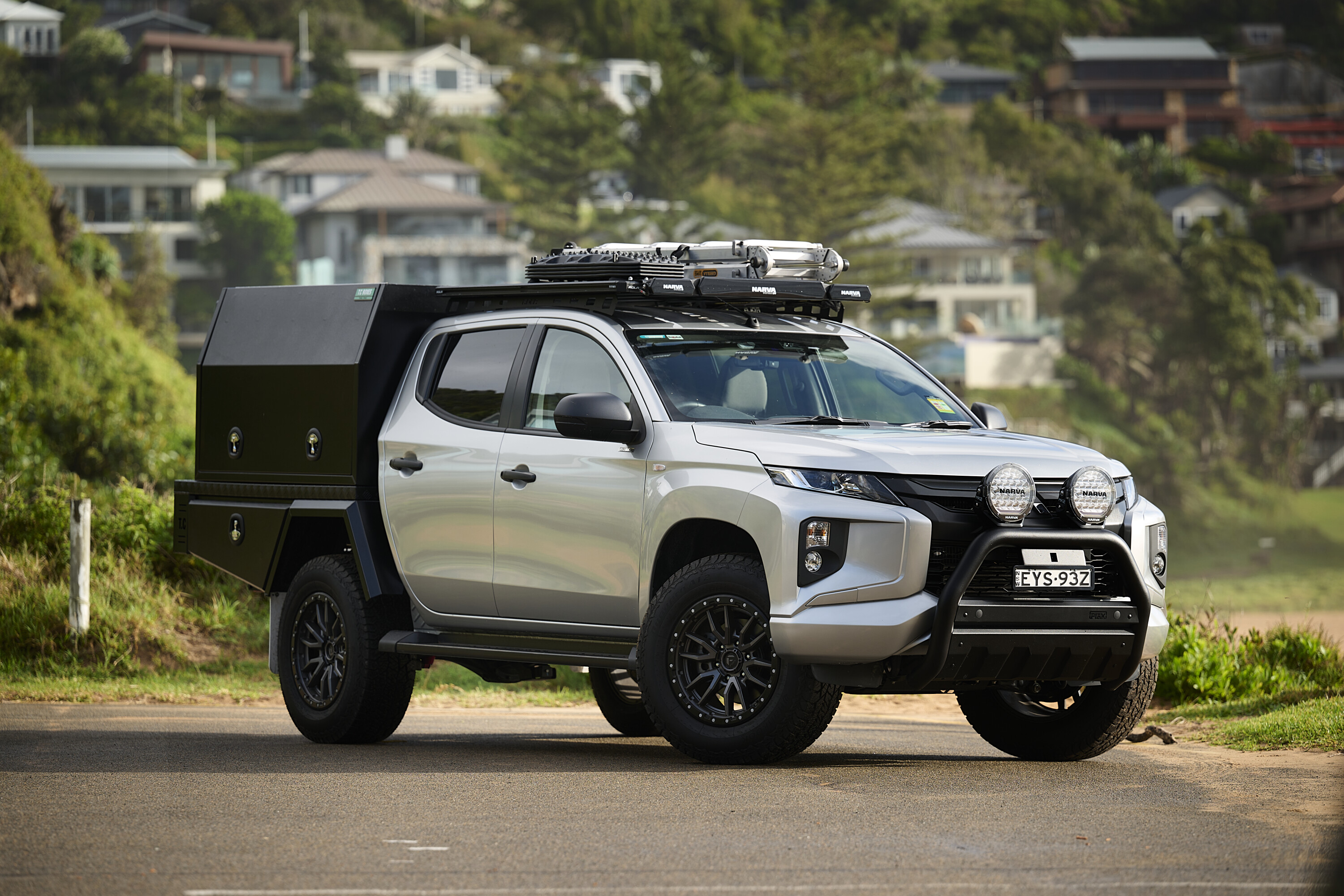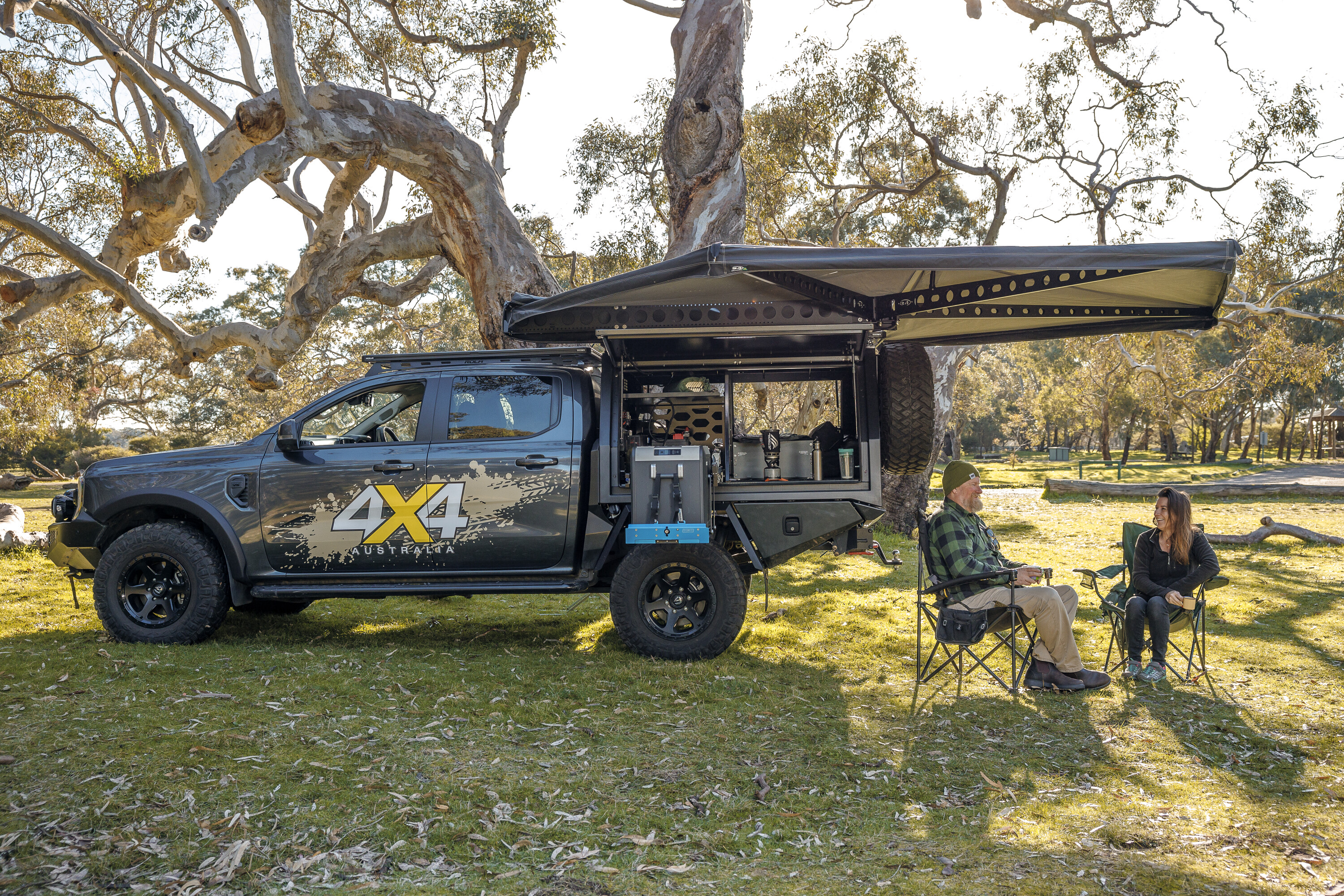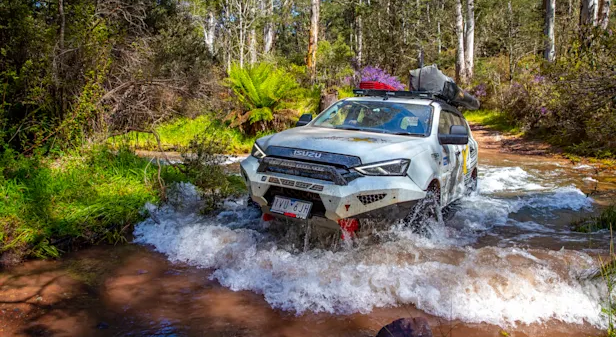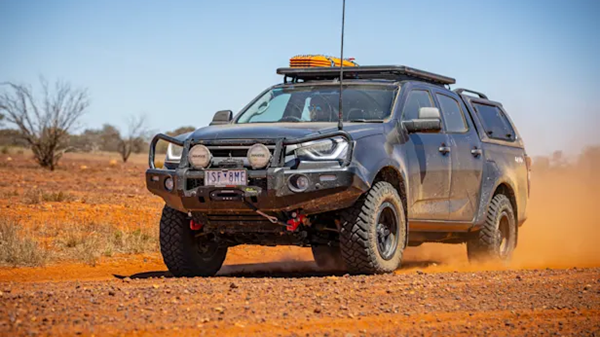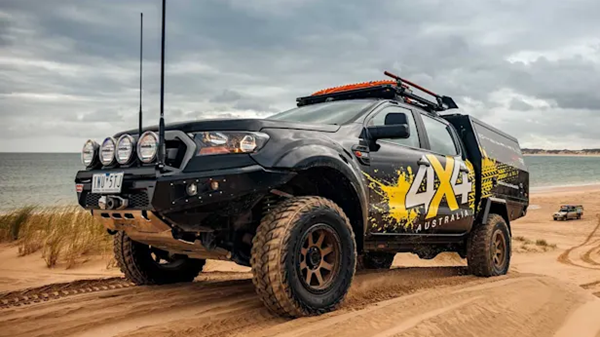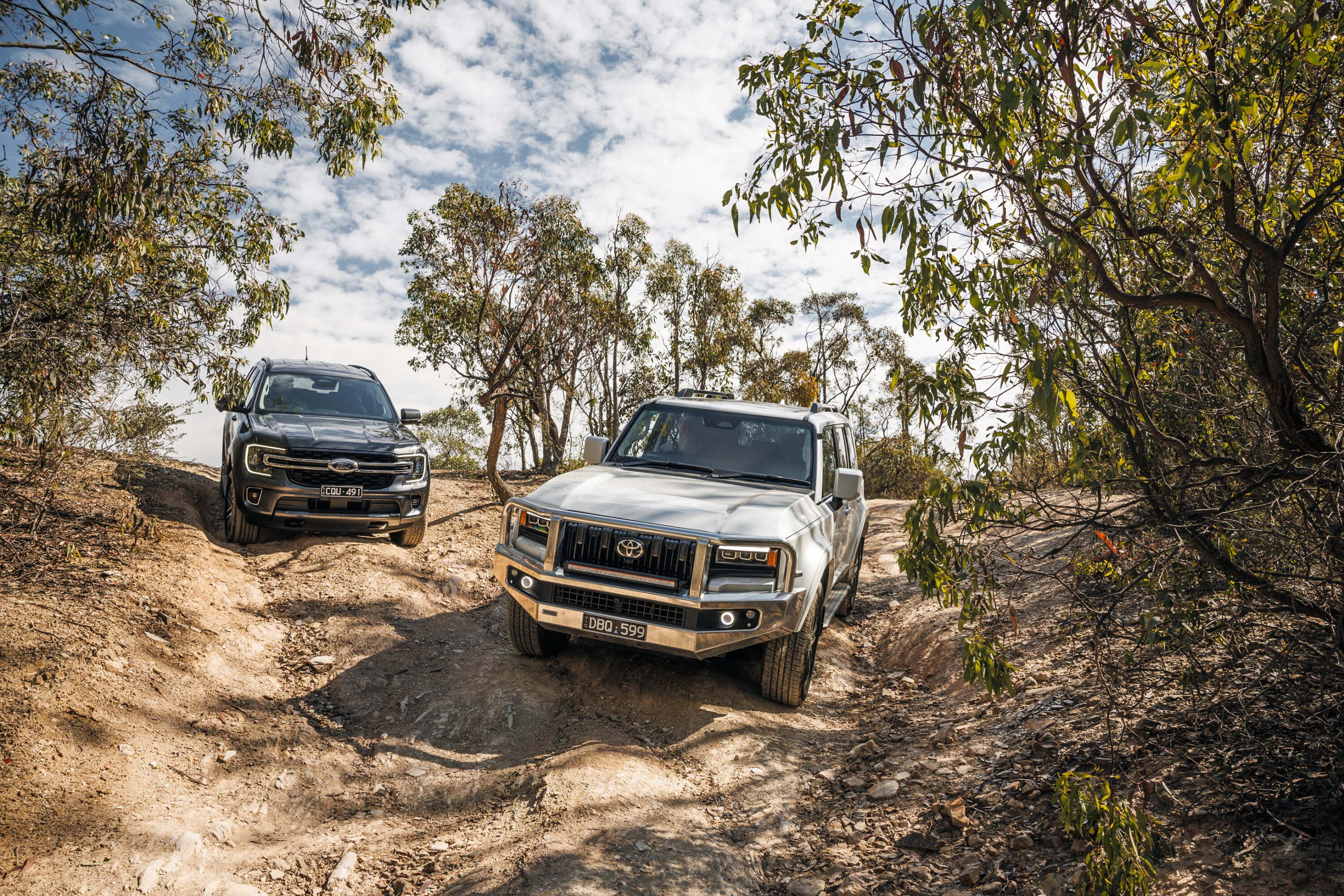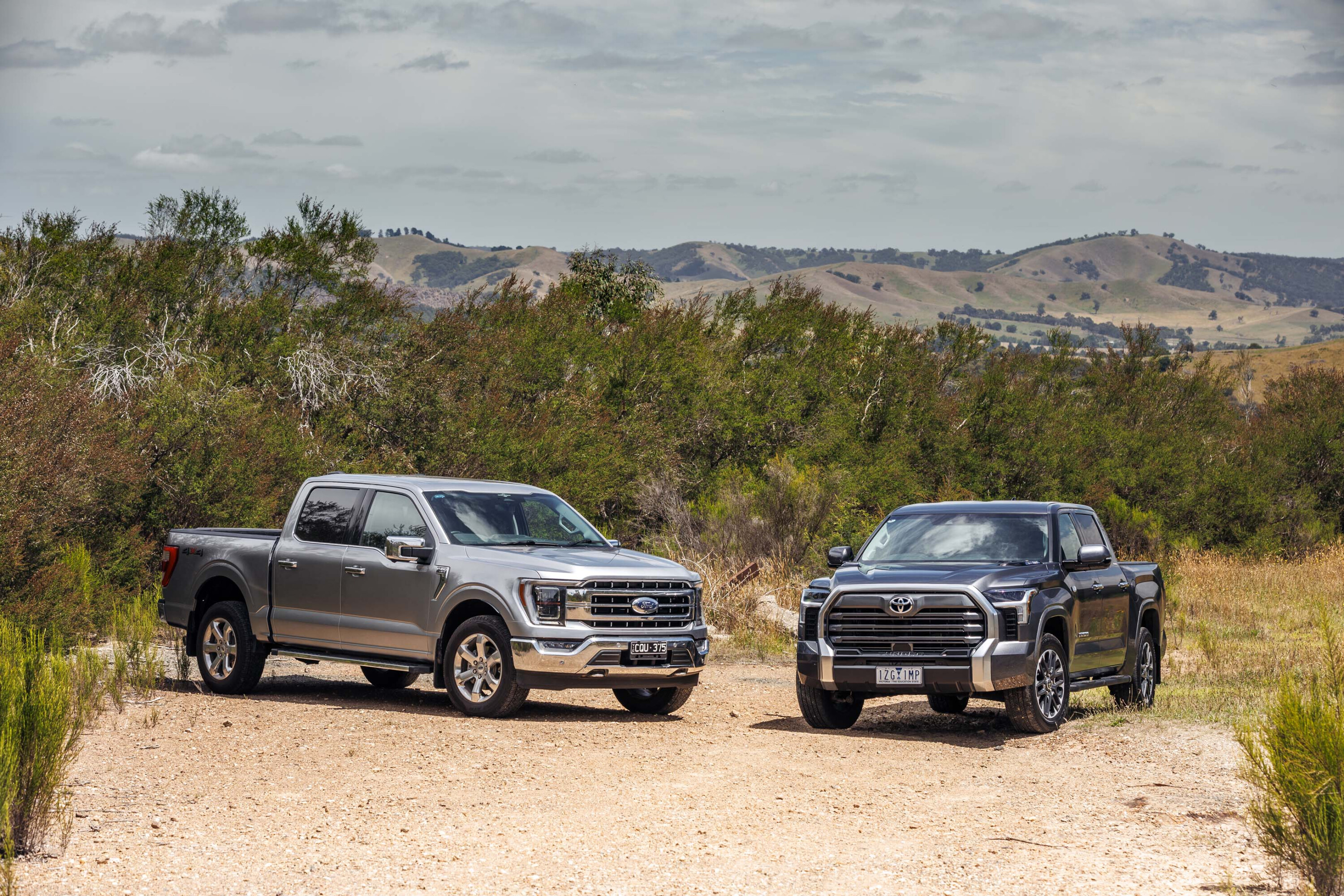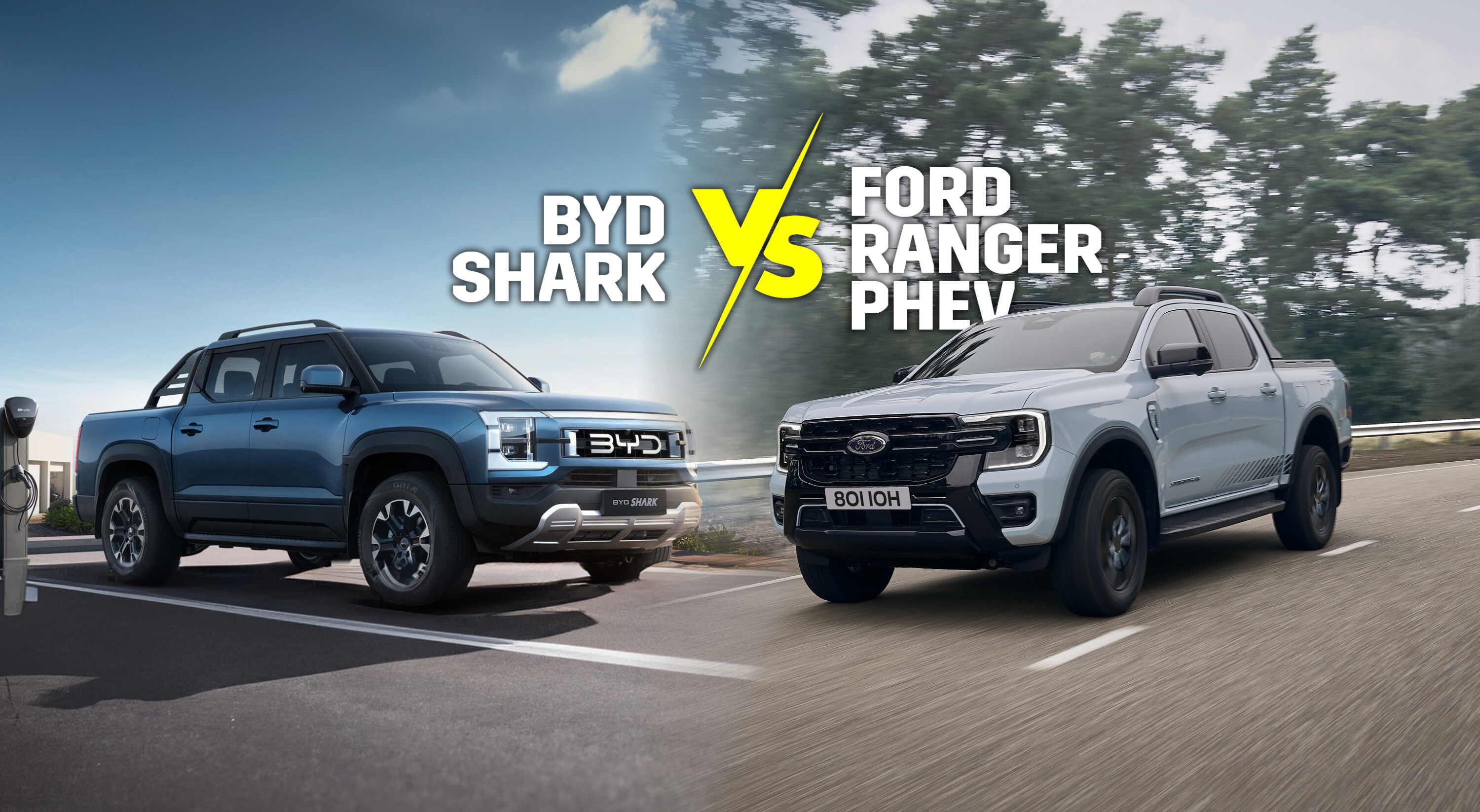Before you turn away muttering, “idiots, why compare a ute with a wagon”, consider this: both of the Ford Ranger Raptor and Jeep Wrangler Rubicon will set you back the high-side of $70K on road; both are super capable off-road yet are also loaded with luxury, convenience and safety kit, and both are conceived for recreational buyers.
The only other showroom stock 4x4s this capable off-road, the LandCruiser 70 and the Mercedes G-Wagen, are significantly more commercial or service in origin and presentation.
More 4×4 gear guides
-
Suspension
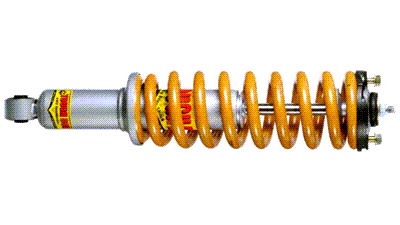
-
Lights
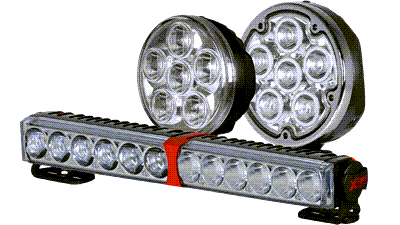
-
Canopies
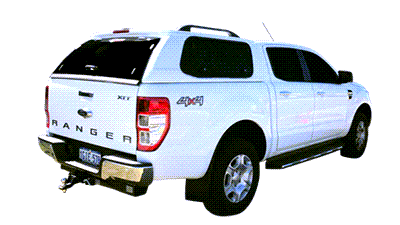
-
Bullbars
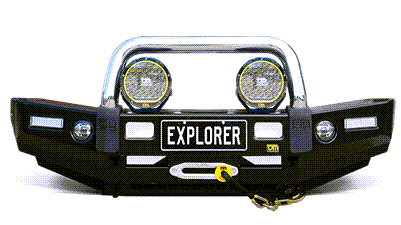
-
Roof Racks
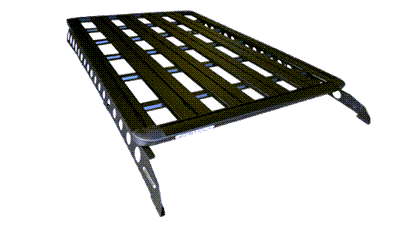
-
Recovery Gear
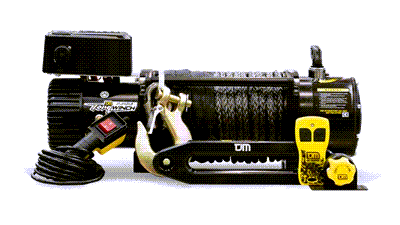
-
Storage
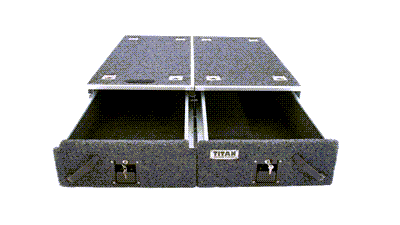
-
Tools
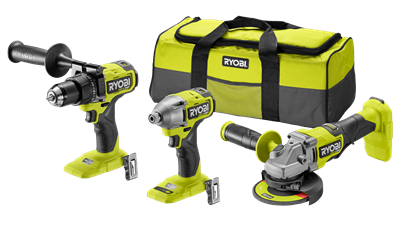
-
Camping
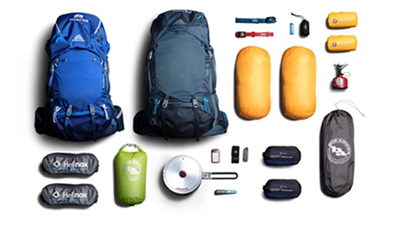
-
Tents & Awnings
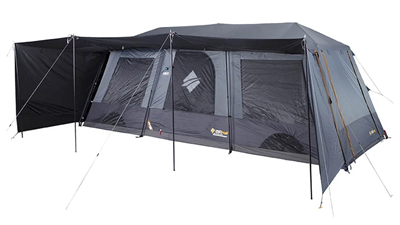
-
Portable Power
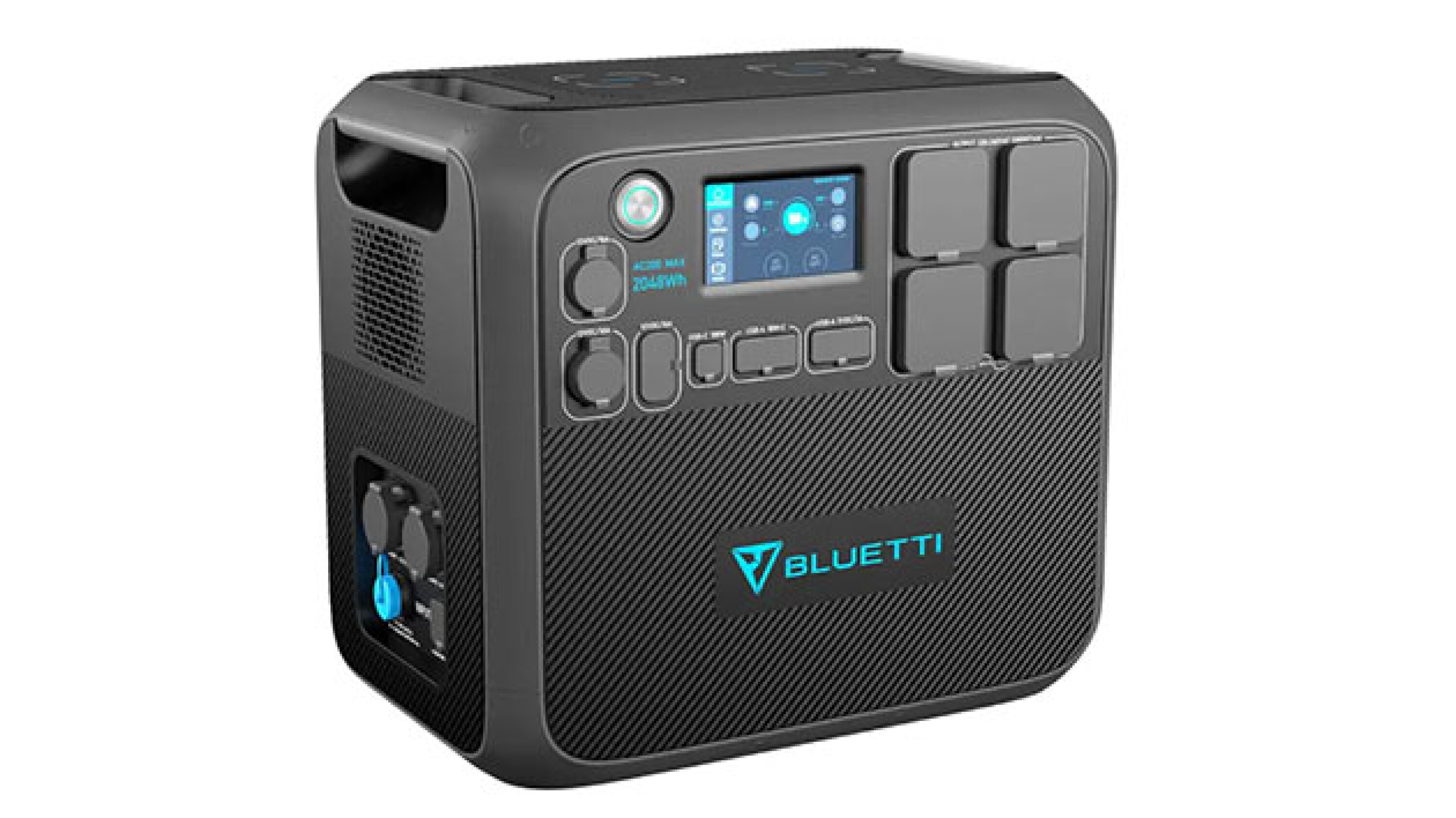
Both Raptor and Rubicon also have high-tech powertrains with small-capacity turbo-diesel engines and automatic gearboxes with more ratios than you would have thought possible a few years back – 18, in fact, between the two of them.
Significantly, they are also factory ‘customs’, both a good deal removed from the bread-and-butter models in their respective model line-ups. And in both cases the factory ‘modifications’ are aimed at making a more capable off-road focused 4×4, not necessarily a better on- and off-road vehicle.
The Raptor is also the reigning 4X4 Of The Year and this all-new Rubicon may well be the next 4X4OTY; although, that’s a contest that won’t be decided until the end of the year. In the meantime, is it Raptor or Rubicon that wins this bout?
Ford Ranger Raptor – Suspended in Heaven
Serious chassis re-engineering, not extra power, is the ford ranger Raptor’s killer punch.
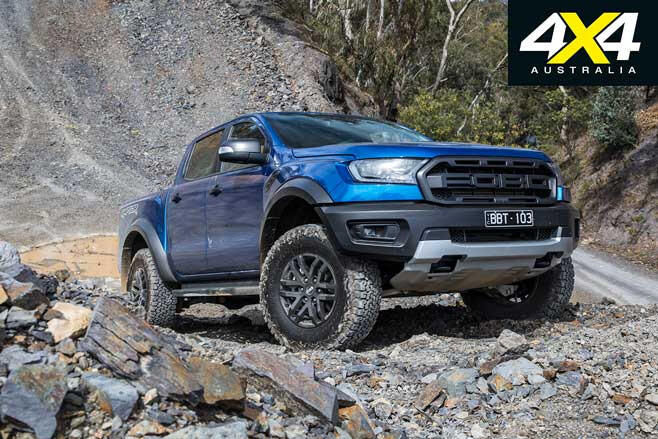
The Ranger Raptor was conceived by Ford Australia off the back of the success in the USA of the F150 Raptor, a desert-racing-inspired factory custom version of Ford’s hugely popular F150 Pick-Up. With help from Ford Performance, Ford’s global high-performance division, the Ranger Raptor was then locally developed off the back of the Ranger ute, which just happens to be largely Australian designed and developed anyway.
If it wasn’t for the phenomenal sales success of the Ranger in Australia, where it now has even toppled the long-term best-selling Hilux, the Raptor may not have got off the ground. Fortunately it did, as serious factory customs like the Raptor don’t come along too often.
Powertrain & Performance
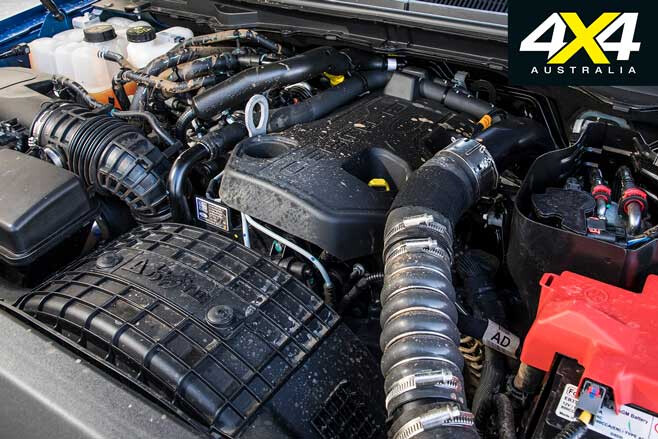
For a ‘hero’ ute it may come as a surprise that the Raptor uses a standard Ranger powertrain, aside from a lower axle ratio to compensate for the taller tyres. That means the same 2.0-litre four-cylinder bi-turbo-diesel and 10-speed auto you’ll find in XLT and Wildtrak Ranger models that’s offered alongside the long-serving 3.2-litre five-cylinder turbo-diesel.
Still, this ‘little’ high-tech 2.0-litre diesel, with its sequential bi-turbo arrangement, is refined, smooth and punchy. The bi-turbo arrangement makes the engine more flexible, with a solid 500Nm available from just 1750rpm and peak power (157kW) not arriving until 3750rpm, both bigger numbers than the 3.2 and achieved over a wider engine-speed range.
Pressed to give its all, it actually sounds more like a bigger diesel than a small diesel, with quite a deep throaty voice. At the same time it also spins through the revs quickly as you’d expect of a smaller engine, helped in this by the relatively close ratios of its 10-speed automatic.
In most part the 10-speed automatic does its job largely undetected with smooth, seamless and timely shifts, but it can sometimes be a little indecisive in picking what gear it wants, and it can produce the odd rough shift.
Side by side, the Raptor just pegs the slightly less powerful but lighter Rubicon, but there’s not much in it. More noticeable and perhaps more significant is the Raptor’s engine is a little smoother and more refined, and generally doesn’t sound or feel as ‘diesel-like’ as the Rubicon’s engine.
On-road ride & Handling
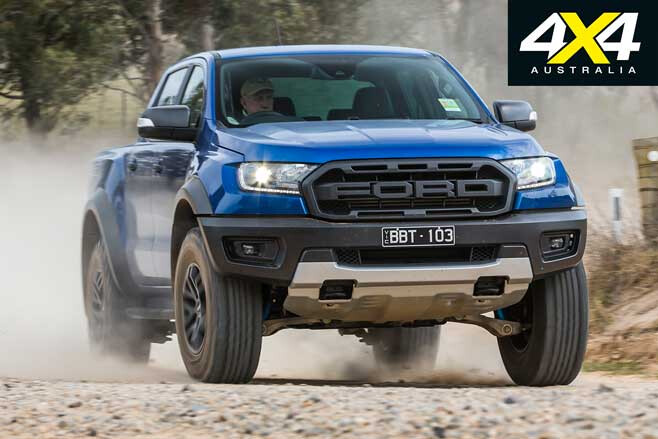
What makes the Raptor special isn’t its engine but its chassis, which has been totally re-engineered from that of a standard Ranger. And while the idea behind that was to make a better off-road vehicle, the ‘new’ chassis actually works brilliantly on-road – the rougher the better.
You can put this down to the extra suspension travel, some 30 per cent all round, that soaks up bumps beautifully.
Coils springs at the rear, replacing the Ranger’s leaf springs, and bespoke Fox-brand racing-technology bypass dampers (the rears have ‘piggy-back’ reservoirs) contribute to the compliance and control.
Longer A-arms up front and a different axle housing at the rear widen the stance (by 150mm) to compensate stability-wise for extra ride height. Finally, the rear axle is laterally located by a sophisticated Watt’s link, a far superior arrangement in terms of chassis control – there’s no rear bump steer compared to the commonly used, cheap, simple but dynamically flawed Panhard rod.
The Raptor then tops all this off with nicely weighted electric-power steering with lots of feel. All this puts it well ahead of the Rubicon in terms of on-road finesse and poise.
Off-road
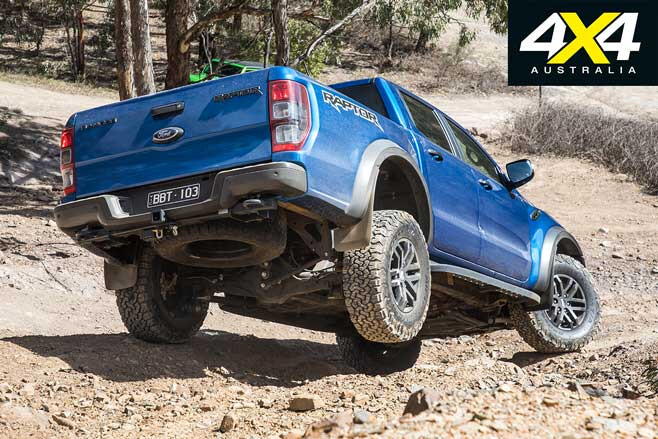
Head off-road in the Raptor and the lofty ground clearance and BFGoodrich LT285/70R17 K02 All Terrains, which surprisingly blunt the Raptor’s on-road dynamics very little, become your best friends. The longer suspension travel is welcome, too, as is the extra underbody protection.
Compared to most showroom-stock 4x4s, the Raptor feels unbreakable; although, with the engine’s air intake under the bonnet lip a snorkel would be good insurance even if Ford claims an 850mm wading depth. Four heavy-duty recovery hooks are also a nice touch.
The Raptor retains the Ranger’s part-time 4×4 system, complete with a driver-switched rear locker. Usefully, when the rear locker is engaged, the electronic traction control (ETC) stays active on the front axle.
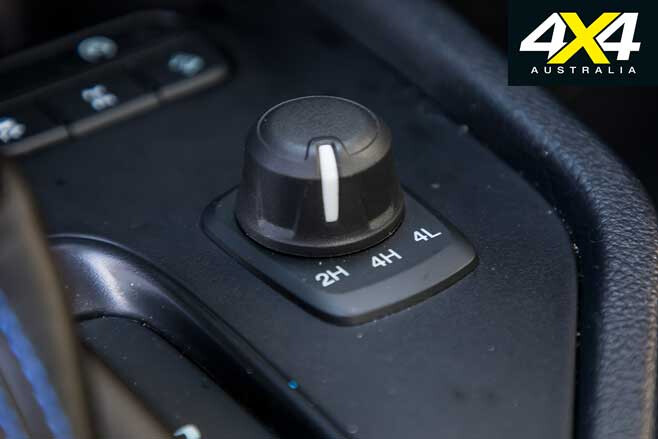
The Raptor also comes with paddle shifters for ‘manual’ gear selection, which is handy off-road, and a ‘Terrain Management’ system to fine-tune the powertrain and chassis for different driving environments.
The settings run to Normal, Sport, Grass/Gravel/Snow, Mud/Sand, Baja, and Rock. All modes bar Rock are available in high range, while all modes bar Sport and Grass/Gravel/Snow are available in low range. These modes vary engine throttle mapping, gearbox shift protocols and electronic traction and stability control calibration.
To get a measure of Raptor and Rubicon off-road, we pointed the two up an off-road pinch that you wouldn’t dream of tackling in any other showroom stock 4×4, except perhaps a LandCruiser 70 or a G-Wagen. The Raptor managed to get up and down with very little fuss, without much more than lifting a wheel and scrabbling sideways a bit as it grabbed for traction here and there.
The over-bonnet vision could be better – it feels like a big vehicle off road, which it is – and the engine braking isn’t great, something you’ll notice compared to the tractor-like gearing in the even more off-road-capable Rubicon.
Accommodation & Safety
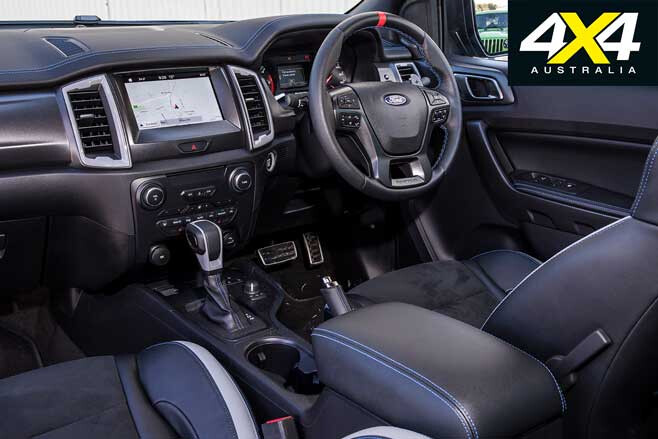
The Raptor has a spacious and long cabin and comes with bespoke leather seats and a heap of kit, none nicer in winter than the heated front seats.
Despite not having steering wheel reach adjustment (tilt only), getting comfortable is easy and the seats are some of the best you’ll find in any 4×4.
If it’s five people you wish to seat, the Raptor also has a spacious back seat that’s actually better for three than the rear-seat of the Rubicon; although, the Jeep gets air vents for the rear passengers, a notable omission in Raptor.
Practicalities
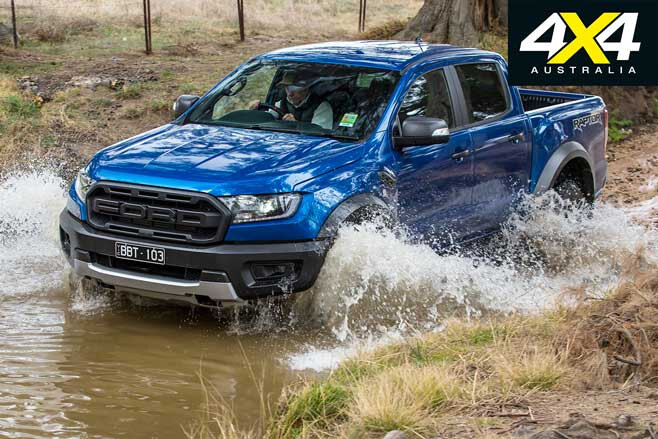
Perhaps the most practical thing about the Raptor is the fact it’s a ute, so it can do things like carry large items you’d never fit into a wagon.
Compared to bread-and-butter Rangers, the Raptor has a lower payload capacity (only 758kg) and reduced towing capacity, from 3500kg to 2500kg. Still, that’s a way better payload than the Rubicon, even if the towing capacity is as good as the same.
What You Get
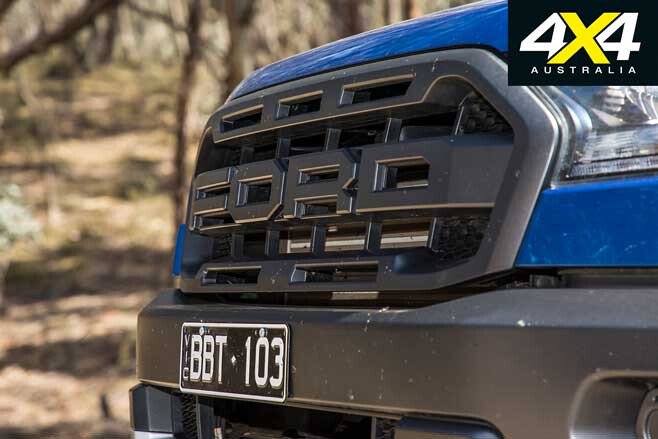
Raptor has keyless entry/start, power adjustable and heated front seats, leather/suede trim, tilt steering wheel adjustment, auto headlight/high beam, rain-sensing wipers, eight-inch touchscreen, USB ports, sat-nav, Apple CarPlay/Android Auto, reversing camera, dual-zone climate, cooled centre console, paddle shifters, tubliner, 12V tub outlet, and a work light. Safety kit includes AEB, lane departure warning and assist, traffic-sign recognition, and six airbags (front, side and curtain).
Jeep Wrangler Rubicon – The Godfather
Nothing says “4×4” louder than a Jeep Wrangler Rubicon.
The Toyota LandCruiser, the Nissan Patrol and the Land Rover company all owe their existence in one way or another to the original World War II Jeep. And the Wrangler Rubicon is the latest and ultimate embodiment of the go-anywhere spirit of that very same, original Jeep.
These days the Wrangler is the only current Jeep model to retain the basic design principles of a separate chassis and live axles at both ends that defined the original WWII Jeep.
The latest – 2019 – iteration of this iconic 4×4 is called the Wrangler JL and it replaces the JK that first appeared in 2006, bringing a new 2.2-litre diesel which is only available in the Rubicon; all the other models have the now long-serving 3.6-litre petrol V6. There’s also a new ZF-sourced eight-speed automatic, the only gearbox offered on Australian models.
The Rubicon, which is also offered with the petrol V6, is only available in four-door, long-wheelbase guise – unfortunately there’s no short wheelbase model – and is distinguished from ‘lesser’ Wrangler models by its impressive off-road arsenal that runs to front and rear lockers, a bespoke transfer case with deep low-range gearing, lower axle ratios, a front swaybar disconnect and mud tyres.
Powertrain & Performance
The Rubicon’s new 2.2-litre diesel, which shares no history with the previous model’s 2.8-litre VM diesel, comes from Fiat Powertrain and has been used previously in the KL Cherokee and some Alfa Romeo models. It’s a modern, Euro 6-compliant single-turbo four-cylinder that claims 147kW and 450Nm.
It’s a much quieter, more refined and more revvy diesel than the old 2.8. With the advantage of the new and slick eight-speed automatic transmission (the 2.8 had a five-speed auto), the general response is much better, even if the power and torque numbers are effectively equivalent.
The Rubicon’s 147kW and 450Nm still can’t match the 157kW/500Nm Raptor, but the Rubicon is a little lighter, so there’s not much difference in terms of outright straightline performance, even if the Raptor has its nose in front.
The Rubicon’s engine can’t quite match the Raptor for refinement, either; it isn’t quite as smooth or quick-revving and has more of a diesel rattle.
Full marks, however, for the Rubicon’s eight-speed auto, which is the slicker all-round performer than the sometimes not-quite-perfect 10-speed in the Raptor.
On-road ride & Handling
Live axles front and back, as the Rubicon has, has never been a recipe for sharp and stable on-road handling, especially at higher speeds on bumpier roads. And while previous Wranglers have never been particularly good in this regard, the JL feels a bit better than before thanks to retuned dampers and springs and revised suspension mounting points.
More significantly, the JL offers a full-time 4×4 setting in the transfer case, which gives better drive and steering stability on wet bitumen and gravel. There’s still a two-wheel drive mode, but what Jeep calls ‘4H Auto’ is a set-and-forget driving mode that can be used on any road surface, sealed or unsealed, wet or dry. This alone makes this new Rubicon distinctly better as an all-conditions touring 4×4 than the previous model, and its full-time 4×4 is something that can’t be matched by the Raptor.
Still, the Rubicon isn’t a particularly dynamic on-road drive. The steering is too light and lacking in feel and precision and there’s some bump steer from both front and rear axles on rough roads. The faster you go and the bumpier the road, the worse it gets; and in this regard the Rubicon is several levels below the high standard achieved by the Raptor under the same demanding driving conditions.
The BFGoodrich Mud-Terrains, as you’d expect, are also not the last word in on-road grip. Plus, they are noisy on the highway, as is generally the case with mud terrains. It would be interesting in more ways than one to drive a Rubicon fitted with good all-terrain tyres like the Raptor, rather than its mud terrains. At least the ride quality is comfortable, even if it doesn’t match the plush Raptor.
Off-road
Live axles front and rear may not be what you want for on-road driving, but they underpin the Rubicon’s off-road prowess. As part of the evolution from JK to JL, there’s even more suspension travel than before, which makes it better than before.
These changes aside, the new Rubicon carries over the defining elements of the old Rubicon, namely front and rear driver-switched diff locks and a front swaybar release which, when activated, adds to the already impressive front wheel travel.
The Rubicon also gets lower axle ratios than non-Rubicon models, and the diesel has an impressive 70.3:1 crawl ratio thanks in part to the 4.0:1 low-range reduction ratio in place of the 2.72:1 in the non-Rubicon models.
If there’s one shortfall with the Rubicon it’s with the ramp-over clearance, which could be better as the chassis crossmember has a tendency to touch down. US-model Rubicons actually get taller all terrain tyres than the 255/75R17s (32-inch) BFGoodrich KM3 mud tyres fitted to the Australian Rubicons, which would help in this regard.
Apparently the axle joints (universal vs CV) used in conjunction with the part-time-only transfer case are stronger, which may compromise the fitment of notably bigger tyres (35-inch, etc.) on Australian models without some aftermarket re-engineering.
Still, this clearance issue aside, the Rubicon out-pointed the Raptor in the tougher off-road conditions we tackled. Its vision is better, too, so it’s easier to place around obstacles, there’s far less wheel lifting, which means better grip, and you can mechanically fully lock the drivetrain, which you can’t do with the Raptor.
The super-low crawl ratio also makes for much better engine braking on steep descents, and it’s handy for climbing, too. Last but not least, the Rubicon’s mud tyres also offer more off-road grip.
Accommodation & Safety
Our test Rubicon was fitted with the optional Luxury Pack, which means leather seats in addition to a long list of other standard kit (see ‘What You Get’) in what is a busy feeling but reasonably well-finished cabin.
The Rubicon has tilt-and-reach steering wheel adjustment and lots of seat height adjustment, which makes it easy to get comfortable. But the driver’s footwell is a bit cramped and the seats are not as comfortable as those of the Raptor, while the cabin also feels more ‘upright’ and traditional 4×4-like compared to the more passenger-car feel of the Raptor. It has a roomy rear seat, and adjustable tie-downs in the cargo area are a nice touch.
Removable roof panels above the driver and passenger make for a unique open-air driving experience and the entire roof can be removed if desired; although, this is not a one-person operation. This feature, which takes the Rubicon from 4×4 wagon to off-road ‘buggy’, is a significant part of its appeal.
When initially assessed, the Wrangler JL (Rubicon included) only gained a one-star ANCAP safety rating, but since that time new safety systems such as AEB have been fitted and to date the vehicle hasn’t been retested.
Practicalities
The Rubicon can’t carry all that much legally, with its payload potentially soaked up just by driver and passengers alone. It’s rated to tow just shy of 2500kg, which is useful enough.
The 81-litre fuel capacity is useful without being exceptional; although, fuel consumption isn’t excessive, even with the upright body and mud tyres, which results in a reasonable touring range.
What You Get
The Rubicon gets keyless start/entry, leather seats (Luxury Pack), tilt and reach steering, 8.4-inch touchscreen, sat-nav, dual-zone climate control, Apple CarPlay/Android Auto, auto headlights, reversing camera, nine-speaker audio with subwoofer, USB ports front and rear, 230V/150W outlet in the rear seat, and adjustable cargo points out the back. Safety kit includes AEB, blindspot monitoring, rear cross-traffic alert, adaptive cruise, and four airbags (two front and two side).
Conclusion
Almost equals?
Both of these vehicles have dual personalities, but in very different ways. Like all dual-cab utes the Raptor is both five-seater passenger 4×4 and a 4×4 ute, with all the broad-spectrum functionality that brings.
For its part the Rubicon is both a 4×4 wagon, yet with the roof off it takes on more of the persona of an off-road or beach buggy. This is a notable feature of the Rubicon that not only sets it aside from the Raptor but also every other 4×4 you care to name.
This difference between dual-cab ute and ‘adaptable-body’ wagon may well decide this issue here for you. The Raptor is also $7K more expensive; although, $2K of this is eaten up if you add the leather pack to the Rubicon.
Despite these differences both Raptor and Rubicon are genuine factory-custom models pitched squarely at off-road use. And to this end both succeed … but by varying degrees. Both also work well on-road; although, again to varying degrees.
The best on-road drive is clearly the Raptor, where its steering precision, handling, stability and ride are all superior to the Rubicon. There’s a smidge more performance too from an engine that’s also more refined and more endearing.
For its part, the Rubicon’s superior wheel travel, fully ‘lockable’ drivetrain, better vision and deep low-range gearing make it the better off-road weapon, even if a little more ground clearance would be handy. Regardless, both of these 4x4s are very good at what they do, but it feels like the Ranger Raptor gains more on-road over the Wrangler Rubicon than it loses off-road, making it the better all-rounder.
Specifications
| u00a0 | Jeep Wrangler Rubicon | Ford Ranger Raptor |
| Engine | 2.2-litre 4-cyl turbo diesel | 2.0-litre 4-cyl bi-turbo diesel |
| Power | 147kW at 3500rpm | 157W at 3750rpm |
| Torque | 450Nm @ 2000rpm | 500Nm @ 1750-2000rpm |
| Gearbox | 8-speed automatic | 10-speed automatic |
| 4×4 System | Dual-range/selectable full-time | Dual-range part-time |
| Crawl Ratio | 70.3:1 | 47.6:1 |
| Construction | Separate-chassis | |
| Suspension (f) | Live-axle/coil springs | Independent/coil springs |
| Suspension (r) | Live-axle /coil springs | |
| Wheel/tyre spec | LT255/75R17 111/108 Q | LT285/75R17 116/113 S |
| Departure Angle | 31.9u02da | 24.0u02da |
| Rampover Angle | 21.2u02da | 24.0u02da |
| Approach Angle | 41.7u02da | 32.5u02da |
| Wading Depth | 760mm | 850mm |
| Ground Clearance | 252mm | 283mm |
| Kerb Weight | 2221kg | 2332kg |
| GVM | 2630kg | 3090kg |
| Payload | 409kg | 758kg |
| Towing capacity | 2495kg | 2500kg |
| GCM | 4876kg | 5350kg |
| Fuel capacity | 81 litres | 80 litres |
| ADR fuel claim | 7.5L/100km | 8.2L/100km |
| Test fuel use | 11.5 litres/100km | 11.6 litres/100km |
| Test fuel range | 654km | 640km |
| Price | $68,950 ($73,275 as tested) | $75,990 |


